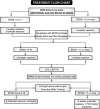Responding to the challenge of Adolescent Perinatal Depression (RAPiD): protocol for a cluster randomized hybrid trial of psychosocial intervention in primary maternal care
- PMID: 32106885
- PMCID: PMC7047361
- DOI: 10.1186/s13063-020-4086-9
Responding to the challenge of Adolescent Perinatal Depression (RAPiD): protocol for a cluster randomized hybrid trial of psychosocial intervention in primary maternal care
Abstract
Background: Adolescent pregnancy is a pressing public health issue globally, and particularly in low and middle-income countries. Depression occurring in the perinatal period is common among women and more so among adolescent mothers. Effective treatments for the condition have been demonstrated in adults but the needs of adolescents are often unique, making such treatments unlikely to meet those needs.
Method/study design: A hybrid effectiveness-implementation research study is described in which a cluster randomized trial design is used to explore the effectiveness as well as the utility in routine practice of an intervention package specifically designed for adolescents with perinatal depression. Consenting pregnant adolescents (aged less than 20 years) who are newly registered for antenatal care are enrolled into the trial if their fetal gestational age is less than 36 weeks and they score 12 or more on the Edinburgh Postnatal Depression Scale (EPDS). The intervention package consists of structured sessions of behavior activation, problem-solving treatment, and parenting skills training, and is delivered by primary maternal health care providers, complemented by support provided by a "neighborhood mother" identified by the adolescent. Mothers in the control arm receive care as usual. The trial is conducted in clinics where the maternal providers are trained to deliver routine depression care with the use of the WHO Mental Health Gap Action Programme, intervention guide. Assessments are undertaken by trained blinded assessors at baseline, at childbirth, and at 3 and 6 months postpartum. The primary outcome, assessed at 6 months, is the level of maternal depression (measured with the EPDS). The secondary outcome is parenting skills (assessed with the Home Observation Measurement of the Environment, Infant-Toddler version), while tertiary outcomes include measures of disability, quality of life, mother-child bonding, as well as infants' nutritional and growth indices.
Discussion: This, to the best of our knowledge, will be the first fully-powered trial of an intervention package specifically designed to address the unique needs of adolescents with perinatal depression.
Trial registration: ISRCTN16775958. Registered on 30 April 2019.
Keywords: Adolescent; Effectiveness–implementation research; Nigeria; Perinatal depression.
Conflict of interest statement
The authors declare that they have no competing interests.
Figures
References
-
- World Health Organization. Adolescent pregnancy factsheet 2014. Geneva: World Health Organization; 2017.
-
- The World Bank . Adolescent fertility rate (births per 1,000 women ages 15–19): united nations population division, world population prospects. 2017.
-
- Nigeria National Bureau of Statistics . Multiple Indicator Cluster Survey, final report. Abuja: Nigeria National Bureau of Statistics; 2011.
Publication types
MeSH terms
Grants and funding
LinkOut - more resources
Full Text Sources
Medical
Miscellaneous



